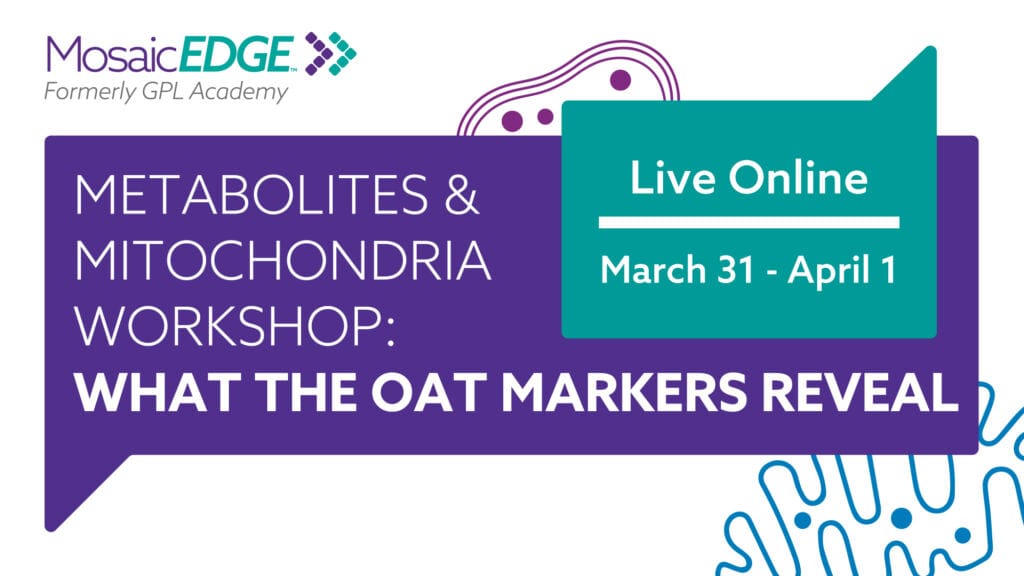
On March 31-April 1, 2023, Mosaic EDGE (formerly GPL Academy) hosted the Metabolites and Mitochondria Workshop: What the OAT Markers Reveal live-streamed online. The following Q+A is a grouping of responses from the workshop presentations.
The material contained within this article is not intended to replace the services and/or medical advice of a licensed healthcare practitioner, nor is it meant to encourage diagnosis and treatment of disease. It is for educational purposes only. Any application of suggestions set forth in the following portions of this article is at the reader’s discretion and sole risk. Implementation or experimentation with any supplements, herbs, dietary changes, medications, and/or lifestyle changes, etc., is done so at your sole risk and responsibility.
Brett Baxter, DC
Q: What form of grapefruit seed extract for mold sinusitis and what dose?
It is an over-the-counter nasal spray that we just recommend the patient buy and use as directed per the printed instructions on the box. It is called Xlear. Dr. Musto who runs Microbiology DX, a sinus culture lab, has seen great results in pre and post-sinus cultures and good zones of inhibition within his in-lab petri dish experiments.
Q: Have you heard of visual snow and if so, are there any OAT markers and do you think it is a mold-related issue?
A: Personally, I would make sure that the patient has seen or will see a neurologist and ophthalmologist to rule out pathology in the back of the eye or lesions in the brain. With that being said I would consider mold as a contributing factor to a patient presenting with visual snow. With that being said I would work them up the same as any other patient with mold illness and swab the sinuses, do an Organic Acids Test, and Mycotoxin study. On the oat test looking at the fungal markers on the MOAT portion, oxalates, and pyroglutamate can be helpful to identify a mold issue. One additional test that may be helpful here is the visual contact test that you can send to the patient through survivingmold.com
Q: Patient with RA, following lifestyle protocol and feeling better but still on methotrexate. Has skin rosacea and blepharitis in his eyelids but now developed cerebellum ataxia and is in a wheel chair, can hardly walk and getting worse by the day. My question is can ataxia affect the brain? Is it similar to MS?
A: Yes! Ataxia can be 100% a brain-derived issue. There is a diagnosis called cerebellar ataxia that I believe is autoimmune-driven. It’s different than MS, but clinically I would think about it in the same way and work them up as an autoimmune patient looking for autoimmune triggers: mold, yeast, bacteria, virus, parasites, environmental toxins, stress, and hormonal issues, etc.
David Berger, MD
Q: What are your thoughts on an elevated vitamin c (447) without supplementation? What could be elevating that level?
A: Food sources, especially in the 24 hours prior to the urine collection.
Q: What is the formula from Kirkman with B6, Magnesium, Vit C IV for adults?
A: https://www.kirkmangroup.com/super-nu-thera-multivitamin-stress-anxiety-formula.html
Q: What natural antifungals do you use for kids?
A: I rarely use them. I have found them to be inferior the Rx versions, with bad taste, multiple doses per day. I suggest probiotics and an anti-candida diet.
Q: If patients present with both salicylate and oxalate issues, which one would you prioritize?
A: If they are both an issue, they both should be avoided.
Q: What are your thoughts on topical B12 application for systemic absorption?
A: It depends on the product. If one was able to document increased B12 levels after vs before use, I would be fine with it.
Q: Do you tend to use spore-type probiotics?
A: No.
Q: I have been (most likely) misdiagnosed with Rheumatoid Arthritis instead of mold exposure. Both me and my daughter tested positive on the myotoxin test for mold. When our home was inspected they found high levels of mold underneath our non-working hot tub (which is located in a hot tub room inside the house). I got suddenly very sick almost overnight (psoriasis, neuropathy, RA, non-stop internal tremors amongst other symptoms) overnight and have been able to reverse most of it through diet, non-toxic lifestyle, and other alternative treatments. It feels though like the “switch” is still turned on ( sensory issues, numbness in the feet, etc). Is there a way to better rid my body of the mold?
A: This is a detailed, personal medical question. I would be happy to do an educational consulation with this individual and they can set this up through www.drdavidmd.com.
Q: Have you seen girls with Autism Spectrum Disorder getting seizures while on their periods? Is there a correlation, any studies on that?
A: Yes, I have seen this before. I do not keep files of studies, but a search of pubmed might provide studies.
Taylor Krick, DC
Q: Could people get mold exposure from the front loading washing machines, particularly the door seal area?
A: Absolutely, front-loading washers are famous for mold around the seal.
Q: Could you talk a bit more about the correlation between antidiuretic hormone and mold illness?
A: ADH is a pituitary hormone that is impacted by CIRS. For much more detail read Shoemaker’s work, but it leads to frequent thirst, urination, or increased susceptibility to static shock
Q: How do you describe the difference between mold toxicity vs colonization?
A: Colonization is mold growing inside your body, that mold needs to be killed, toxicity refers to mold toxins that have stored inside your body from a water-damaged building. You can have one without the other, or you could have both.
Q: What are some of your strategies for reducing ammonia?
A: Fix the gut dysbiosis.
Q: Can you tell us about the map behind you?
A: Ha! It’s all the metabolic pathways in the body. Roche biomedical makes it, they are free online!
Q: Can you share aldehyde study with graph of “overload”?
A: https://actaneurocomms.biomedcentral.com/articles/10.1186/s40478-019-0839-7
Q: Where can we learn more from you and the tools you use in your practice?
A: https://www.autoimmunedocpodcast.com/ by listening to my podcast or through my youtube channel https://www.youtube.com/channel/UCSAKgeiblE8CFUVrmd58dWw
Q: Please share fatty acid beta-oxidation studies.
A: https://www.wjgnet.com/1007-9327/full/v18/i22/2756.htm
Q: Why do some patients’ sinus issues become worse when starting treatment and when do you know to push through the symptoms?
A: I have no idea, we each have a different degree of pathogen burden and epithelial inflammation/resilience.
Q: Is there a correlation between low cholesterol, diabetes and low carnitine?
A: Possibly via the liver, but not that I’m aware of.
Q: Are there any botanicals for sinus mold colonization you would recommend for small children and what would be the best mode of application?
A: Propolis, xylitol, maybe silver. I would purchase a nasal spray made for kids.
Q: What are your thoughts about healing and sealing leaky gut before addressing pathogens, fungus, etc.? Or would you work on healing LG at the same time as addressing fungus, pathogens, etc.? Please explain your protocol.
A: Same time – can’t heal the leaky gut with pathogens and infections present!
Q: I’m not seeing on your website or on the YouTube channel page how to purchase the TENS unit. Can you direct us where to go?
Q: Would you think about recommending a person or with fungal, mold, and sinus challenges along with certain OAT indicators have their gel under eye fillers removed – since it is toxic?
A: Perhaps! I might look to test reactivity to the toxins, glutaraldehyde for example I don’t know what is in those things but it can’t be good.
Q: Can you use Biocidin vaginally?
A: Yes, the capsules according to their usage documents. I’ve had people do that successfully.
Jean Lawrence, ND
Q: What’s the latest in the day you’d take something like Adrenal Desiccated? (concern about it potentially being too energizing)
A: 2-3 PM
Q: Can low vit c be indicative of adrenal fatigue?
A: Absolutely!
Q: What if a client has low cortisol function, low DHEA, low estrogen, but normal testosterone. Would you focus on the cortisol or DHEA first?
A: All-around adrenal support – minerals, B5, adrenal glandular.
Q: Supplements/Herb for sleep?
A: Ashwaganda, GABA, Passion Flower, Valerian, Kava Kava
Q: How to build up a stomach acid after H. pylori particular in older people?
A: Betaine HCL
Q: Do you have any reservations giving glandulars long term for clients with autoimmunity?
A: It depends on the glandular – I also do frequent testing to see how they’re doing.
Q: What would you suggest for a 5 yrs old with chronic constipation and extreme anxiety?
A: GabaFlo spray from Apex Energetics.
Q: What is your H. pylori protocol?
A: Goldenseal two tabs b.i.d. for at least a month.
Q: Are there studies that show SSRIs contribute to adrenal dysfunction?
A: I haven’t seen any – but I know that those meds are affecting the serotonin pathways for sure in some way.
Q: Any information related to blood clot issues? On warfarin – can they use gingko?
A: I would proceed cautiously with that patient, and use CyrutaPlus from SP at 6 per day.
Q: What was the name of the adrenal tonic from Standard Process?
A: It’s from MediHerb – Adrenal Tonic Phytosynergist.
Q: Do you have experience treating a patient with topical steroid withdrawal who has difficulty falling asleep after chronic use of topical steroids for eczema and has multiple food allergies and sensitivities?
A: That has to be done slowly unfortunately bc the body is so used to it – and yes have done that.
Q: Can you send me the protocol you mentioned for Hiatal Hernia?
A: Here you go.
Q: Would you consider that “type A personality” is actually just describing those with adrenal dysfunction?
A: Usually high cortisol.
Jaban Moore, DC
Q: What is your preferred method for consuming minerals, I use and usually recommend Trace Mineral Drops, is that not a great way to absorb?
A: Minerals are best obtained from a well-sourced, whole-foods diet. It’s also helpful to supplement with beef liver, high-quality sea salt, coconut water, and Cellcore’s CT minerals – per individual needs.
Q: For Dr. Moore, what water filtration system did he say is the best?
A: My favorite is the My Pure Water Distiller. They have multiple sizes with different capacities.
Q: What is the urine test you’re referring to (outside of OAT)?
A: The urine mycotoxin test (MycoTOX Profile)
Q: How can trauma and diabetes be related? Any suggestions to support clients with diabetes?
A: Trauma and diabetes are related in several ways, as both can have an impact on an individual’s physical and mental health. Here are some possible connections between trauma and diabetes:
Stress and cortisol levels: Trauma, particularly severe or prolonged traumatic experiences, can cause increased stress and activation of the body’s stress response system. This can result in elevated levels of cortisol, a stress hormone, which has been linked to insulin resistance, a condition where cells become less responsive to insulin, leading to higher blood sugar levels. Insulin resistance is a common precursor to type 2 diabetes.
Lifestyle factors: Trauma can often result in changes to an individual’s lifestyle, such as disruptions in sleep patterns, poor nutrition, and decreased physical activity. These lifestyle factors can contribute to the development of risk factors for diabetes, such as obesity, sedentary behavior, and poor diet choices, which are known risk factors for type 2 diabetes.
Mental health impact: Trauma can also have a significant impact on an individual’s mental health, such as post-traumatic stress disorder (PTSD), depression, and anxiety. These mental health conditions can affect an individual’s ability to effectively manage their diabetes through self-care behaviors, such as adhering to medication regimens, monitoring blood sugar levels, and maintaining a healthy lifestyle.
Coping mechanisms: Trauma can sometimes lead to maladaptive coping mechanisms, such as emotional eating, substance abuse, or self-medicating with food, which can increase the risk of developing diabetes. For example, emotional eating or reliance on unhealthy foods as a coping mechanism for trauma-related distress can lead to poor diet choices, weight gain, and ultimately an increased risk of type 2 diabetes.
Health disparities: Some populations, particularly those who have experienced significant trauma such as adverse childhood experiences (ACEs), may also face health disparities that contribute to a higher risk of developing diabetes. These health disparities can be related to social determinants of health, such as access to healthcare, socioeconomic status, and systemic discrimination, which can influence an individual’s risk of both trauma and diabetes.
Q: When do you use homeopathy in your protocols? Homeopathy is good for mental health too.
A: We often use homeopathy to support drainage in the very beginning of protocols with very sensitive clients or children. Pekanna Big 3 is one of our favorite tools to utilize if a client needs drainage support, but is unable to tolerate cellcore drainage supplements.
Q: I love your funnel. Do you keep your initial labwork to a certain maximum of tests you will run as to not overwhelm the patient with too many actionable items at the follow-up visit?
A: We try to choose 2-4 tests that will give us the most valuable information. This will depend on the client, their history, symptoms, and concerns. If a client has the finances and is wanting to perform more tests, we can absolutely do this! More information is always helpful to have!
Q: Please share what supplements you prefer to use. Appreciate all your information. Great presentation! Thank you
A: We use a range of supplements and herbs. In our clinic we often use Byron White formulas, Apex Energetics, Seeking Health, Cellcore, Supreme Nutrition, Xymogen, Biotics Research, and Quicksilver, to name a few.
Q: Do you worry about stirring up toxins and making a person worse? How do you know where to start?
A: We want to minimize the risk of causing worsened symptoms so I like to support the body with lifestyle tools and nervous system regulation tools first. Then we can add in nutrients and other mast cell stabilizers to support the body. Once these 2 things are in motion, then we can slowly detox. At times, I have clients start with only a pinch of a binder – instead of the entire capsule. Slow is always better when dealing with a sensitive person!
Q: Does Dr. Moore provide education/training outside of speaking event or webinars? Where can I access his protocols?
A: I have a few courses available now! You can find them from the link in my Instagram bio. I currently have a parasite program and a foundational program, with more on the way!
Kurt Woeller, DO
Q: How do you feel about binders (I prefer Cellcore) to help mop things up when they are broken down, especially candida?
A: Binders are fine and a good idea overall for all of the gut pathogens.
Q: If mold levels are mildly elevated, do you follow-up with a mycotoxin test? Or just assume it is present and treat accordingly.
A: Consider the MycoTOX Profile, a separate test. Do not rely on the OAT to solely dictate whether or not to do MycoTOX Profile.
Q: Are normal reference ranges on the OAT similar to “normal” ranges on a traditional lab report? (ie, not optimal or functional level)
A: Each lab can set their own ranges based on their study population.
Q: Do we have a list of more detailed information of each marker?
A: Get a copy of the Clinical Significance of the Organic Acids Test.
Q: I had previously submitted a request for seeing OAT case reports paired with a 5-day food log. Here is one example of why relating to tartaric acid: DOI: 10.1373/clinchem.2004.036368. Could this be addressed in the review of tartaric acid? Dr. Lord appears to say that fungus metabolizes tartaric acid and does not produce it. Is it simply an association pattern?
A: I am not familiar with Dr. Lord’s information. Tartaric likely comes from other sources, but Aspergillus is one source.
Q: Why #56 NAC is high 7.4 (normal <0.28)? Significant? No NAC supplementation, #58 Glutathione 26 (normal 10-33) for age and gender, #59 Methylation 3.7 (normal 0.03-1.8)?
A: Likely not deacetylating the NAC to cysteine. The enzyme that does this is Zinc dependent.
Q: What are your clinical results in autism treating pathogens?
A: Many great responses. I have an entire course called Autism Mastery Course – https://autismmasterycourse.com.
Q: Can you distinguish between current and past exposures to mold, chemicals, etc? Would high levels of mold be evident in OAT from prior exposure?
A: Mold markers on OAT are showing colonization. It is difficult to know how long they have been there unless you have a previous test.
Q: It is common to receive zero results for levels or vitamin C in 99 percent of patients from Venezuela. Is it possible that this result is related to the distance and shipping of the sample?
A: Not likely. This is common everywhere.
Q: Often probiotic strains are grown from Aspergillus. Can this influence the results?
A: Not that I know of.
Q: What about 5 year old boy, struggling with an elimination issue since birth (colic, constipation), anxiety right now, what would be better OAT or CSA?
A: OAT in my experience. Constipation in kids is normally lack of hydration, fiber, and deficiencies like magnesium.
Q: In your experience, what have you seen drive up Mycophenolic Acid the most on the MycoTOX Profile?
A: Penicillium exposure
Q: What are the differences in lithium types and how does that affect the pts differently when they take the different types including lithium carbonate?
A: Pick up a copy of Dr. Greenblatt’s book on Nutritional Lithium.
Q: Does it mean that in some cases, as the B2 comes out high, is it that it is being consumed a lot and we see those “remains” of its use in the urine?
A: The B2 markers is glutaric. If glutaric is high it indicates a B2 deficiency.
Q: When a patient shows low or deficient in glutathione, do you prefer supplementing with glutathione or precursor such as NAC?
A: Typically, I like glutathione. But it depends on the type of patient and sensitivities. NAC can work too.
Q: If vit D is low, would you supplement with D, or check Mg, or liver/kidney ability to convert 25OHD to usable form?
A: Typically, supplement with D, but also check levels overtime.
Q: It is common to receive zero results for levels or vitamin C in 99 percent of patients from Venezuela. Is it possible that this result is related to the distance and shipping of the sample?
A: Vitamin C is unstable in liquid urine, especially at room (shipping temperature). Thus if its elevated you know it was elevated to start. If not detected you don’t know if it decayed during shipping.
Q: 72 yr old female; disabled X 20yr Lyme ( borrellia, babesia, viral (herpes 2, 6 etc) Most difficult issue is extreme fatigue; sleep dysregulation ( tx with clonazapam and trazadone X 15 years) Recent OAT = tartaric at 27, oxalic acid 227, succinic 48, fumaric; creosole 62; 4.9 malic 11, HVA 5.5 HVA/VMA 4.1, HVA/DOPAC 2.0 , suberic 2.3, DHPPA 0.73. Mycotox Profile Ochra 16.9; Steric 5.32; mycophenolic 197; Zia 280; Citrinin 251 Stool test pretty clean Low buturate and SCFA ; calprotectin 224; gut healthy bacteria all 4+ except lactobacillus is 1+; no candida ( gliotoxin 0) or other pathogenic organisms. House is clean of active mold and pt rarely goes out of the house. Question is: can this all be coming from endogenous mold colonies? pt has no symptoms in gut or sinus. How do we know if these out of range mycotoxin levels are causing problems? What other tests would be important to consider.
A: With biological toxins, it can be very difficult to say at what level an indiviudal is going to experience symptoms. How the patient will react, is highly variable, and can be dependent on various components such as; nutritional status, co-infections, other morbidites, age, gender, body composition, etc, etc. Moreover, there is no clear way to determine the exact source of the mycotoxins. If there are no pulmonary, GI, ear, or sinus symptoms, I wouldn’t be as inclined to think colonization.The fact her mycotoxin load is elevated, with various mycotoxins from different genuses make it suspicious of an external exposure. May be worth questioning how she r/o it is not in her current environment. If you need further support, feel free to schedule a consultation with one of the clinical educators.
Q: Would low co-q10 resulting from statin use show up on an OAT?
A: Yes, this could definitely occur.
Q: I have been (most likely) misdiagnosed with Rheumatoid Arthritis instead of mold exposure. Both me and my daughter tested positive on the myotoxin test for mold. When our home was inspected they found high levels of mold underneath our non-working hot tub (which is located in a hot tub room inside the house). I got suddenly very sick almost overnight (psoriasis, neuropathy, RA, non-stop internal tremors amongst other symptoms) overnight and have been able to reverse most of it through diet, non-toxic lifestyle, and other alternative treatments. It feels though like the “switch” is still turned on ( sensory issues, numbness in the feet, etc). Is there a way to better rid my body of the mold?
A: Yes. Read Neil Nathan’s book called “Toxic”, and Jill Crista, ND book on mold and mycotoxins.
Q: Do you advocate avoidance of dairy (Casein A1) in leaky gut? Is A2 milk any better?
A: A2 milk. But prefer Camel Milk overall for any cow dairy sensitivity.
Q: What do you recommend to avoid Herxheimer reaction when treating candida?
A: Binders, as well as going low on dosing of antifungals. Some people are just very sensitive.
Q: I have a client who claims Biocidin (specifically the grapefruit seed extract) gave her significantly increased easy bruising. Have you seen this before? I have not.
A: I have not seen this.
Q: Curious about binder options: GI Detox+ vs Pectasol C when considering anti-Mold/Yeast program.
A: I use a lot of GI Detox.
Q: What does it mean if a retest is higher in mycotoxins than the first one after a Quicksilver catch and release binder. Does it mean you retested too early (1 year after the date of retest) or does it mean that you are testing the detoxing of the mycotoxins, or is it that they are still exposed to school and they are remediating (probably not the best remediation techniques).
A: It could be both things, but likely things are coming out from detoxification.
Q: Heavy metal testing for children to address candida? Does Mosaic have a test? Does the lab help support how to detox heavy metals?
A: They do have heavy metals testing, here.
Q: I noticed that you recommend niacinamide or niacin. Would you recommend TruNiagen or nicotinamie riboside supplements instead? Or do you think that it’s not that much better?
A: I will be doing a webinar soon on nicotinamide riboside.
Q: What is it that can cause lithium deficiency? Lack in diet? Or what uses it up?
A: Lack of diet and drinking too much bottled water.
Q: In regard to the high calcium in the cell you spoke about; how does this apply to someone who has extremely high potassium levels? How would you balance that? More magnesium or would that infer with the calcium, or would it help dissolve the excess calcium in the blood?
A: Magnesium controls calcium and potassium. I would lean on magnesium and avoid calcium supplementation.
Q: I did an OAT on a 15-month-old boy. He is high on candida markers 1,3,7,8. HPHPA is high normal @ 198. #39 Quinolinic is high normal at 8.7 and #75 4-Hydroxybutyric is high at 13. What do you make of #39 and #75 and do you have guidance, please? He is not yet diagnosed with ASD, but definitely has some symptoms.
A: QA can be trending for a number of reasons from increased interferons to decreased levels of Niacin, but there are lot of other factors to conisder here. 4-hydroxybutyric can be dietary influenced, but there are other factors to conisder here. To get a more comprehensive assessment of the test, may want to consider a clinical educators.
Q: What are the contraindications for lithium? I thought there was a reason not to use lithium, but I cannot remember what it was.
A: Thyroid suppression can occur with high dose.
Q: Would neurological inflammation also affect limbic system development in a child? Can you just use Glutathione instead of NAC? Would neurological inflammation also affect limbic system development in a child?
A: Yes to all.
Q: Can high Quinolinic acid lead to a functional iron deficiency?
A: Yes, but likely would take a lot of it.
Q: If a person has pain in their legs and at times it prevents them from walking. Nothing has been found so far as the cause. Is it possible oxalates could be an issue?
A: Yes. Read Sally Norton’s book called Toxic Superfood.
Q: Do people with oxalate sensitivity have to be on a low oxalate diet permanently?
A: No. Typically they do not. But, every person is different.
Q: How do you explain arthritis symptoms in phalanges right after candida treatment?
A: Immune activation, systemic inflammation. There could be an oxalate and/or histamine component too.
Q: If a patient has had a cholecystectomy what can provide to assist fat digestion with meals?
A: Digestive enzymes that contain HCL and bile acids.
Q: Why would there be oxalate dumping just because intake is suddenly reduced? Why would there not be a dynamic equilibrium between the crystals and the serum level? I would expect that as oxalate crystals are broken down the serum level would trend up which would slow the breakdown of oxalate crystals.
A: Depends on people’s body chemistry and their overall levels of oxalates.
Q: What is your opinion of high PH water for helping flush out oxalates? Increasing water intake of course.
A: Definitely increasing water intake. Not sure about high pH water.
Q: So my OAT and my daughter’s OAT results came back high in glycol and oxalic but we really don’t eat a lot of oxalates, is this because of candida overgrowth then?
A: Could be.
Q: Can you speak to the recommendation around not supplementing with calcium for oxalate kidney stones?
A: Absorbable calcium could be an issue. The citrated calcium taken with meals should not be a problem.
Q: Does a decrease in Clostridium markers, such Cresol decreasing from 100 to 60, mean a improvement, such as symptoms, or leaky gut?
A: Yes. This can be related.
Q: If patients are on a Dopamine supporting supplement would that impact the OAT when assessing the metabolites?
A: Yes, it could.
Q: I am confused because Parkinson’s is a dopamine def. state which is why we give dopamine to Parkinson’s pts. Why would markers for clostridium be high in Parkinson’s disease if clostridium inhibits the conversion of dopamine to NE or the metabolism of dopamine making it high? I find this contradictory. Please explain.
A: This discussion is about high cytosolic dopamine causing elevatad quinones which are toxic to the brain.
Q: Can you comment on excess histamine and the Organic Acids Test. Any markers that indicate this is an issue? How it can relate to oxalates?
A: There is no marker for histamine that I am aware of on the OAT.
Q: I am wondering why someone’s Aconitic would be low. I see issues with high numbers but nothing about low numbers.
A: There is no know clinical significance. It is common. I am looking into it more.
Q: Do you know anything about Leber’s Hereditary Optic Neuropathy (LHON)? I have a client with this type of blindness that seems to have chronic clostridia.
A: I know about it, but not enough experience in what to do. Personally, I would work on mitochondrial function.
Q: Is bile supplementation harmful to clostridia overgrowth?
A: Bile can trigger spore deformation if there is a lot of clostridia passing through the small intestine.
Q: How often do you treat clostridia in those without bowel symptoms?
A: Always
Q: What are some reasons for an elevated hippuric acid, as well as marker 15- 4 hydrozypheylacetic and HPHPA?
A: Usually diet causes this level to go up from increased activity of normal digestive bacteria.
Q: So my 6 year olds OAT results showed L HVA/DPAC ratio what does that mean? High oxalate levels and Tartaric and arabinose elevated too.
A: Sometimes that can be indicative of slower COMT activity.There are certainly other factors, and it’s difficult to say without seeing the whole test, but COMT is something to consider with a low HVA/DOPAC ration.
Q: Do patients prescribed lithium tend to stay on Lithium Orotate indefinitely, like a person may on other vitamins or minerals?
A: No. My goal is not to have them on lithium supplementation permanently.
Q: With thyroid issues, would the OAT be a good option? What markers would we look at for connection to thyroid?
A: No markers on OAT for thyroid.
Q: How long can urine be frozen before sending it in? Evidently, we had a patient who froze their urine for 40 days. Are the metabolites impacted by this? If so, what is a safe number of days?
A: Metabolites are generally very stable. The most unstable are acetoacetic acid and vitamin C. Generally if AcAc is elevated initially so is betahydroxybutyrate. Over weeks AcAc will decline but not BOHB. Vitamin C will also slowly degrade over time. So if it’s elevated you know it is there. If low – you don’t know if it decayed. We don’t recommend freezing for more than 7 days, but all the other metabolites would be stable even up to 40 days.
Q: How many of the clostridial cases have no bowel symptoms?
A: Many. In my experience about 50%.
Q: Did he go over the Orotic level?
A: Linked to ammonia detoxification problems. Complicated chemistry. Often mildly high from dysbiosis.
Q: Have you at GPL/Mosaic registered any changes in test results and patterns during the SarsCov19 epidemic?
A: Interesting question. No obvious broad patterns in OAT, GPL-TOX Profile, or MycoTOX Profile that we are aware of. When acutely ill, clearly the literature suggests an increased risk of ketoacidosis and hyperglycemia with new onset Type 1 or Type 2 Diabetes and/or worsening diabetic control in someone with known diabetes.
Q: What is your opinion of the GI MAP? Do you use it in your practice?
A: I do not personally use.
Q: It is enough to test for heavy metals in hair, that is, the information it generates is reliable, or it is preferable to test for heavy metals in urine with prior chelation the night before the sample is taken.
A: Hair is okay to start. But urine testing before and after chelators moving forward.
Q: I do not like evaluating an OAT without a 5-day dietary log since all food and drink influence what we see. I am not sure how anomalies can be best evaluated if we don’t know exactly what the individual has had. That said, I am looking for a case study library with OAT from individuals on keto diet, etc. Specifically, I am thinking about an OAT that indicated alpha oxidation in addition to potentially lipid oxidation. How could a Carnitine transport issue be confidently assessed if the intake log was not provided? I would really like to see diet logs paired with lab reports. It would be great to have a browsable case study library with marked abnormalities, diet, etc. Looking forward to the deep dive.
A: Good idea in doing a 5-day diet diary. Perhaps Mosaic and their client list could be useful here.
Q: What is a better option then Culturelle to go with Biocidin for clostridia?
A: Core Biotic from Researched Nutritionals.
Q: How can I contact Dr. Woeller to treat my kid?
A: Contact my practice manager Leigh at SCMedicalCenter@gmail.com




